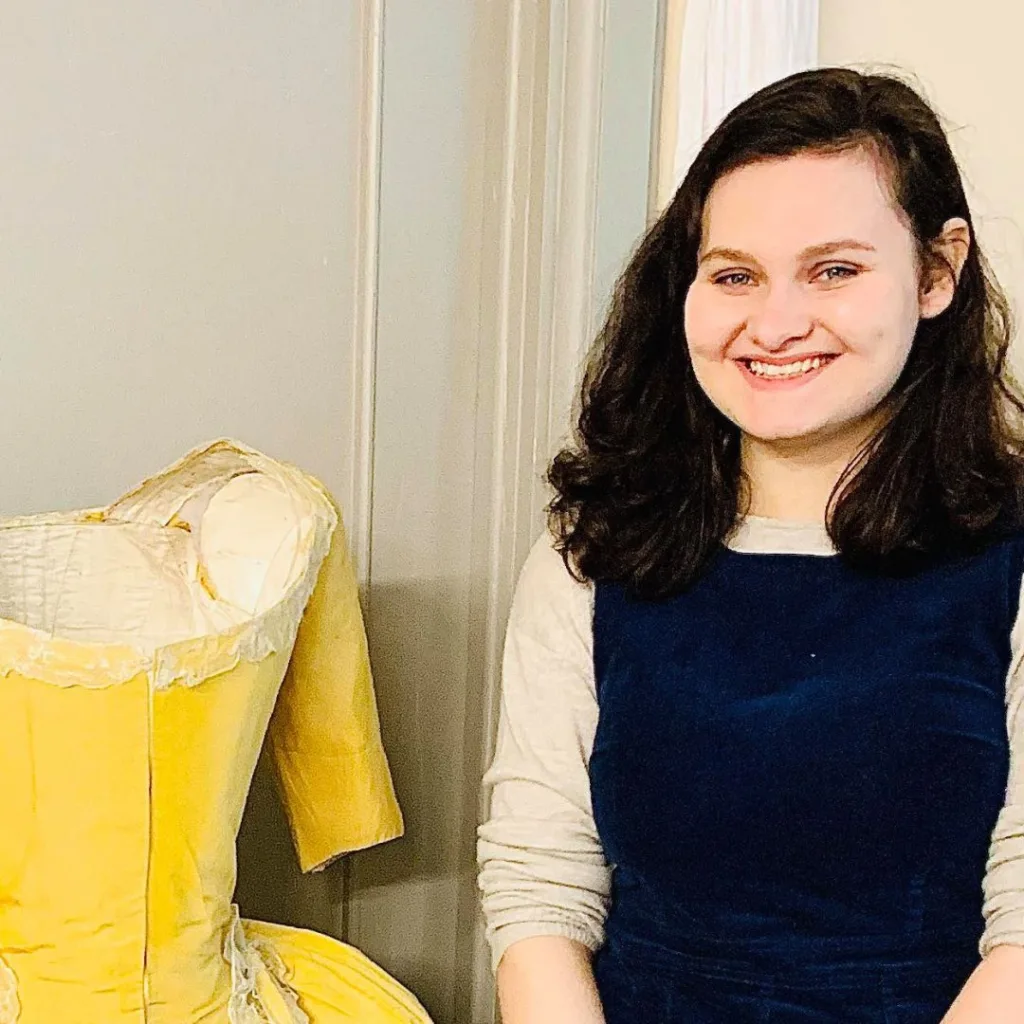The Bowes Museum Blog

Meet Kezia Cosson #BowesStaff

Hi, I’m Kezia Cosson one of the new textile conservation interns at The Bowes Museum. Before this internship I studied Conservation of Cultural Heritage at the University of Lincoln. This was an object conservation course which specialised in frame and ceramic conservation. I’ve always had an interest in textiles so it has been amazing coming to The Bowes Museum and getting the opportunity to broaden my knowledge and experience when it comes to dresses and garments. I’ve worked on so many textiles this past month as part of this internship that it was hard to pick one to focus on for this blog.

Fig. 1 Kezia Cosson working on the gown
I’ve chosen a silk christening gown which was made in 1780. The gown came to the Museum as part of a project from Tullie House Museum and Art Gallery Trust in Carlisle. This was a very satisfying object to work on. It is very rare in conservation that everything goes to plan and treatments work first time, which thankfully they did on this project. Since the christening gown was also nearly two hundred and forty years old it was in amazing condition pre-treatment with only some yellow discolouration and areas of darker staining along with some open seems and weak areas of thread.

Fig. 2 christening gown before treatment
When textiles first come into the Museum they are frozen to kill any pests and their eggs on the surface and to prevent mould growth. This is carried out before the object is introduced to the rest of The Bowes Museum’s collection so as not to spread anything from the new garments to the rest of the collection.
Freezing over, treatment was ready to begin in earnest, with a wet clean.. Wet cleaning textiles can often take whole days to complete, the first time I did a wet clean at the museum I told my mum about it and she said: “Couldn’t you just stick it in the washing machine instead of all this faffing?”
I think it’s safe to say my mum is not cut out for a future in conservation. But if you are thinking the same thing, museum textiles are incredible delicate and cannot withstand the amount of pressure a washing machine creates. Sponges are used lightly over the surface of the garment to agitate the fabric slightly while cleaning and to make sure the detergent gets through…

Fig. 3 wet cleaning sponge treatment
Once the wet cleaning process was finished the gown began to look a lot paler and lost a lot of its yellow colouration. The darker staining, which can be caused by sweat, was also reduced, sometimes stains from salts like these never fully go but that’s not the main goal with wet cleaning; the removal of anything which could cause further harm to the item is the objective, the lessening of a stain is often an added bonus.

Fig. 4 Gown drying after wet cleaning
Once the gown had dried entirely the next stage of treatment, the stitching of the seams, was put on hold. The reason being that all of the tassels on the dress had dried tangled up from the bath and none of them were lying down smoothly, as they had been before the wet cleaning.

Fig. 5 tassels after wet cleaning
This was soon remedied with the use of a humidifier and weights. For the same reason Museum textiles can’t be machine washed they also can’t be ironed. So to remove creases and make things like these tassels lie flat, a gentler method is used. The humidifier creates steam like an iron but it is not heated and it has much more precise controls when it comes to steam output. Once this is used on the tassels and they have been held into the shape they need to be in a small weight is then added. The weight is wrapped in Tyvek® to act as a barrier between it and the gown. This process was carried out over the whole surface.

Fig. 6 weights being used on unruly tassels
Once the gown had been entirely weighted and the tassels straightened out the plan continued as normal. With the next stage being the stitching of the hem line. This area was loose and fraying so couldn’t be stitched down immediately as the loose threads wouldn’t hold the seam for very long. The loose fabric was then laid onto a patch of colour matching silk which was then sewed down to act as the seam.

Fig. 7 loose seam pre-treatment

Fig. 8 seam after treatment
Once this was done and some areas of netting were added, the treatment of the gown was finished. This object has been a very visually satisfying piece to work on because of how much has changed; from the colouration to the tassels.

Fig. 9 Finished christening gown
Thank you so much for trudging through my first ever blog post! I know with how much I’ve already learnt through this internship in the space of just over a month that I’m going to learn so much more throughout this year. I hope to gain experience with costume mounting I am going to make more blog posts on all of the interesting stuff we’re working on in the Museum.
Written by Kezia Cosson, Textile Conservation Intern, Heritage Fund & ICON Intern in the Conservation Department at The Bowes Museum.







